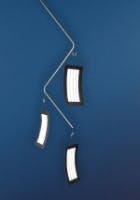GE Lighting is demonstrating OLED lighting technology that it hopes to commercialize beginning in 2011. The company has partnered with Konica Minolta and demonstrated the technology at the recent Light+Building tradeshow and will do so again next month at LightFair 2010 in Las Vegas, NV.
The OLED demonstration relies on flexible, 3×6-in, ultra-thin panels that Konica Minolta plans to produce using a roll-to-roll manufacturing process that's been underdevelopment since November 2009. GE has based its OLED design on Konica Minolta's thin-film technology. Konica Minolta was the first company to develop blue phosphorescent materials that are combined with multiple layers of film to produce a white OLED.
GE and Konica Minolta began working together on OLED technology in 2007, but clearly the technology is still in the earliest of stages in terms of commercialization. Zoltan Vamos, GE Lighting’s Budapest-based global general manager of lighting technology said, “We’re still experimenting and imagining a future with OLEDs but we think our approach will allow us to apply light to literally any surface at a thickness of just a few sheets of paper.”
OLED technology has certainly garnered the interest of lighting designers. “OLED technology represents the biggest potential for new product development and advances in the lit environment,” comments Simon Fisher, director of product design with LAPD Lighting Consultants, Lemsford Village, Hertfordshire, UK. “The potential contained within flexible thin film lighting is enormous and holds the key to changing the way we design and coordinate lighting into our architecture and environments.”
OLEDs offer many of the advantages of LED lighting including energy efficiency and no hazardous materials such as mercury. OLEDs can also be dimmed like LEDs. OLEDs could prove superior to LED lighting in many cases because the light is diffused across a panel as opposed to focused in a narrow beam, But to date, no one has managed to manufacture OLEDs at reasonable cost points, and that's the challenge the GE and Konica Minolta face.






